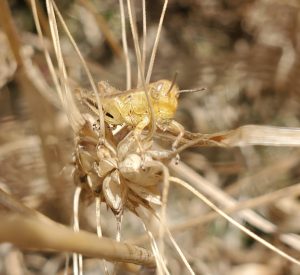June 26, 2021
 A field of ready to harvest wheat was observed infested with 4th to 5th star grasshopper nymphs in Salem County. While waiting for positive identification from entomologists familiar with the differences in the nymp identification, these nymphs appear to be differential grasshoppers (Melanoplus differentialis). The uniform yellowish color of nymphs observed, is an indication the population is quite high. Lesser populations tend to be more green in color. Additional fields of wheat, corn and soybean on the same farm all had nymphs present but were not at economic threshold yet.
A field of ready to harvest wheat was observed infested with 4th to 5th star grasshopper nymphs in Salem County. While waiting for positive identification from entomologists familiar with the differences in the nymp identification, these nymphs appear to be differential grasshoppers (Melanoplus differentialis). The uniform yellowish color of nymphs observed, is an indication the population is quite high. Lesser populations tend to be more green in color. Additional fields of wheat, corn and soybean on the same farm all had nymphs present but were not at economic threshold yet.
Visual counts observed walking into the field were more than 4 as they hopped away fro

A cucumber beetle in the top right corner on a soybean leaf with grasshopper feeding hole
m a square foot area, repeated in multiple locations. This confirms the population is very high. The threshold for nymph stage grasshopper populations causing economic injury is 15 – 20 per square yard. (Four or more per square foot; nine square feet in a yard = more than 20 per square yard = high infestation.)
Because grasshoppers move from preferred forbs like alfalfa and hay fields, and field edges, into cereal crops it is recommended each cereal grain field not yet ready to harvest due to high moisture content be observed to assess thresholds.
When grasshopper nymph levels are this high, the damage to unharvested cereal grains can be concernin if the adult phase coincides with near ready moisture crops, because their feeding can clip the dried grain head stem and both phases chew on seed head grains.
There is no standard for the level of clipped seed heads per say. Monitoring is the best method to determine if harvest will resolve the issue or if a foliar insecticide is needed to protect the grain quality and yield.
The active ingredient Rynaxypyr (Chlorantraniliprole, IRAC 28) found in Dupont insecticide Coregen and FMC’s insecticide Prevathon are labeled for foliar application of grasshoppers in multiple vegetable, field and forage crops.
“Growers can make a foliar application of Prevathon insect control by ground, air or overhead sprinkler chemigation. It has a short re-entry interval of four hours, a favorable worker protection standard profile and a short PHI.” – FMC website, https://ag.fmc.com/us/en/insecticides-miticides/prevathon-insect-control
Once wheat is harvested, grasshoppers will fly to corn and soybean and alfalfa regrowth. Japanese beetles were present in these crops but currently at low levels. Feeding damage may be misidentified as japanese beetle damage when it is actually an indication of grasshopper pressure building. Nymphs were present in adjacent corn and soybean fields but at low levels.
Monitor soybean and young corn fields closely for signs of adult grasshopper feeding through August. Note that a dense swarm of differential and two-striped field crop grasshoppers can destroy the leaf area of a crop in just a few hours.
The following links have useful identification and detailed management recommendations for various stages of grasshoppers on various crop stages of development. The soybean research link shows the defoliation thresholds in soybeans.
Identification https://www.youtube.com/watch?v=bgi6De5NDIw
Identification https://www.youtube.com/watch?v=bgi6De5NDIw
Identification http://idtools.org/id/grasshoppers/factsheet.php?name=13190
Economic importance http://idtools.org/id/grasshoppers/factsheet.php?name=13190
New Jersey species in 2005 https://njaes.rutgers.edu/pubs/publication.php?pid=fs290
Coragen label http://www.cdms.net/ldat/ld8KF045.pdf
Soybean reasearch https://soybeanresearchinfo.com/soybean-pest/grasshoppers/
Prevathon label https://ag.fmc.com/us/en/insecticides-miticides/prevathon-insect-control

